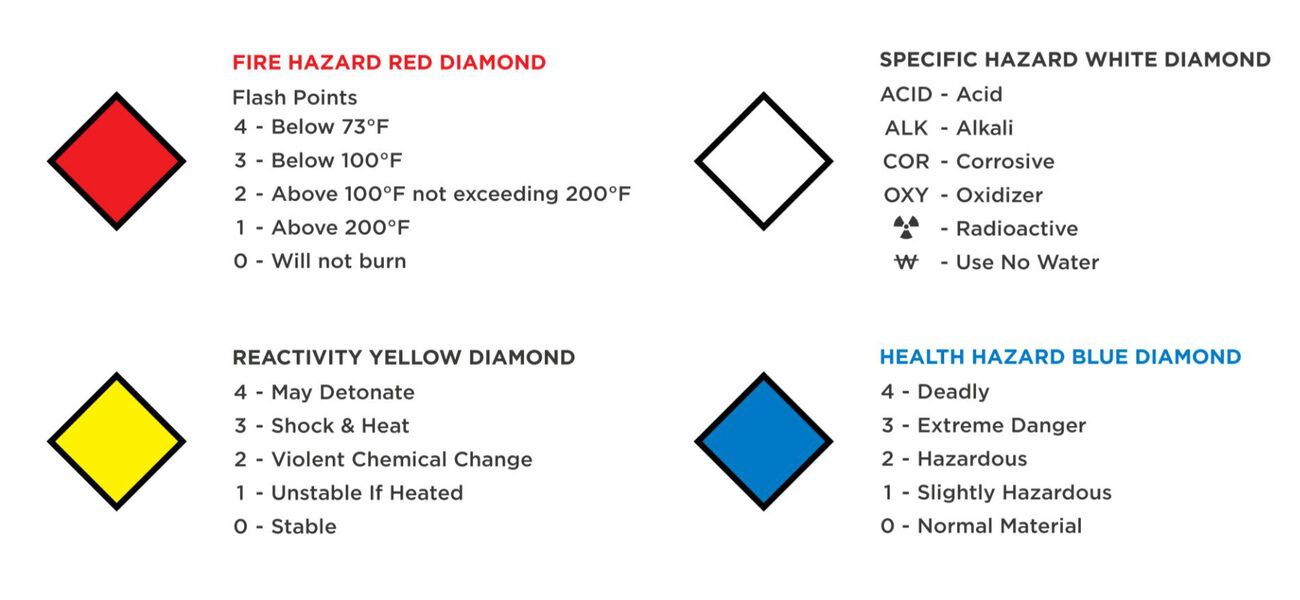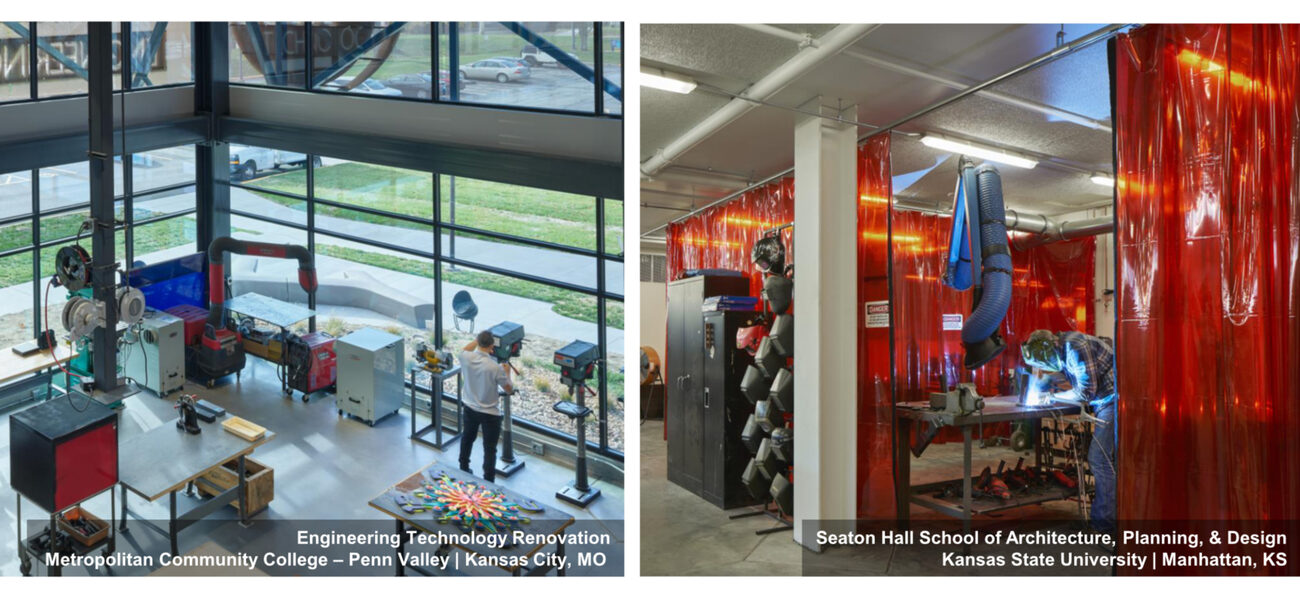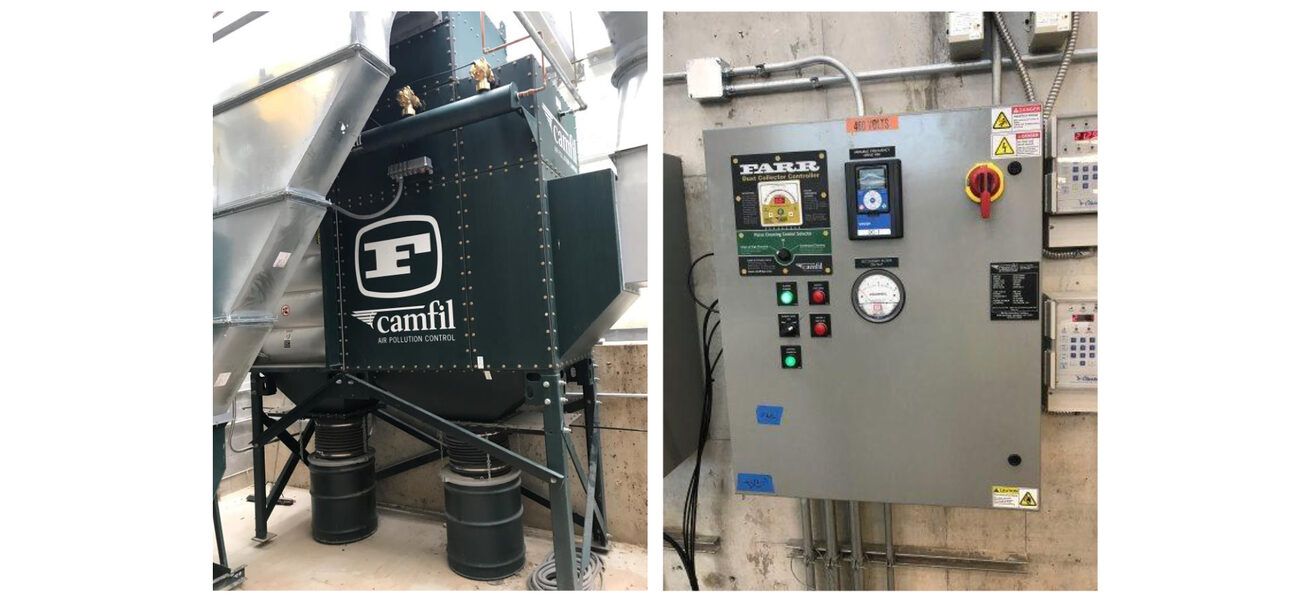The number of makerspaces has increased 200% nationally in the last decade, with no sign of slowing down. A combination of factors is driving this growth: a shortage of workers in skilled trades; the return of advanced manufacturing to the United States, incentivized by recent federal legislation, including the Inflation Reduction Act and the CHIPS and Science Act; and the broad trend toward experiential, hands-on learning for the whole gamut of engineering education.
“Tech schools, community colleges, and universities have all responded with programs and facilities to train the next generation of labor,” says Danny McGrail, science and technology practice director at Henderson Engineers.
This bodes well for the future of the labor force. But given the type of technology and materials used in these spaces, they also present a multitude of code, infrastructure, and safety challenges.
Start with a Hazard Analysis and Risk Assessment
The National Fire Protection Association (NFPA) diamond graphic is helpful in identifying different categories of hazards and their severity. Once hazards have been identified, risk assessment comes next: What is the risk of exposure to humans when using the space? Flammable materials, hazardous dust, fumes, and off-gassing are some of the possible safety and health risks that require mitigation.
For risk mitigation strategies in makerspace design, these are some commonly referenced standards:
- NFPA 652: Standard on the Fundamentals of Combustible Dust
- NFPA 664: Standard for the Prevention of Fires and Explosions in Wood Processing and Woodworking Facilities
- NFPA 30: Flammable and Combustible Liquids Code
- NFPA 33: Standard for Spray Application Using Flammable or Combustible Materials
- NFPA 51B: Standard for Fire Prevention During Welding, Cutting, and Other Hot Work
- International Mechanical Code (IMC)- Chapter 510
- International Fire Code (IFC)
- Industrial Ventilation – A Manual of Recommended Practice (IVM)
Typically the hazard analysis and risk assessment is performed by the institution and their environmental health and safety (EHS) team, with assistance from the design team. The EHS team may include an industrial hygienist, fire marshal, a code consultant, or some combination of these. However, not all institutions, especially smaller ones like K-12 schools, have a robust EHS team. In this case, engineers or other knowledgeable professionals would need to fill in gaps in knowledge.
“The important thing for owners, and even architects and engineers, is that if you don’t have experience with these kinds of highly technical spaces, you need to include someone on your team who understands the standards,” explains Kelley Cramm, mechanical technical manager at Henderson.
A Bird’s-Eye View on Risk Mitigation for Typical Equipment
Makerspaces come with a variety of equipment, each with specific safety requirements that are sometimes drawn from multiple standards in technically nuanced ways. In each case, scale, duration, and frequency of activity are key variables to weigh when designing risk mitigation that is not just effective but also practical.
Laser and Plasma Cutters: These are used for precise cutting and engraving with metal, wood, or plastics; are usually computer-controlled; and typically come with a direct exhaust for off-gassing, which can vary depending on the materials used.
3D Printing: The key is to identify the type of resin used in the filament to determine the potential for hazardous off-gassing, which requires direct equipment exhaust, usually enclosed around the printer. Metal and plastic 3D printing almost always requires direct equipment exhaust.
In smaller 3D printing spaces, where the off-gassing is benign or minimal, it may be sufficient to increase ventilation and exhaust with a traditional exhaust fan, “probably to one CFM per square foot, or four to six air changes per hour (ACH), provided there is enough building ventilation to offset the exhaust,” suggests McGrail. “But you probably don’t need full-blown lab exhaust fans and everything else that comes along with that.”
“If there are restrooms nearby, one simple way to increase exhaust would be to tie in an exhaust duct from the restrooms above or behind the printer,” adds Cramm.
CNCs (computer numeric controls) and Lathes: These automated machines are either bench- or floor-mounted and are commonly operated with general room exhaust, but sometimes come with direct equipment exhaust, depending on materials used.
Spray Painting: In terms of scale, painting can range from a small room for hand spray painting, to a full spray booth for larger jobs involving air-operated spray guns. All spray painting requires exhaust for ventilation and fire prevention.
The IFC defines a “Limited Spraying Space” as a painting area where the aggregate surface area to be sprayed does not exceed 9 sf. According to the IMC, this space would require 6 ACH of ventilation.
Larger jobs require a spray booth that is fully exhausted through a dedicated duct system with air that does not recirculate. Additionally, the booth needs to have a face velocity of 100 feet per minute. Given the large exhaust demand, it is good to know the size of the spray booth early in the design process to ensure there is enough conditioned makeup air.
Additionally, K-12 schools fall under a certain occupancy code that allows painting only in a one-hour fire-rated room, which means the painting room must be kept separate from other activity areas.
For storage, the paint itself, along with paint thinners, cleaners, and other solvents, may all be flammable and require special storage. In small quantities, a flammable storage cabinet is sufficient. On a larger scale, a hazardous materials storage room is necessary.
Welding: The IVM has a whole section on risk mitigation for welding. Welding fumes vary depending on what is being welded, the size of the welding rod, and the duration and frequency of the welding. If welding is quick and infrequent, fumes can be managed with a portable exhaust snorkel, which filters and recirculates the air in the welding area. Longer-duration welding using fixed stations might employ an articulating snorkel exhaust, with welding curtains to protect eyes. For full-scale welding, the most effective option would be a partially enclosed welding table with a slot hood, or a downdraft table.
Cutting, Grinding, and Dust Collection: Any cutting and grinding requires dust collection, using separate systems for metal and wood, both of which can be highly combustible. According to NFPA 652, a dust hazard analysis is required anywhere there is combustible dust. A dust hazard expert would need to perform this analysis and give specific recommendations.
Most woodworking equipment has direct connections for dust collection. For small-scale woodworking, a portable dust collector like a shop vacuum will do, while larger-scale woodwork requires fixed dust collection. Floor sweeps are also used to capture any particles missed by the dust collection system.
In the early stages of design, McGrail advises installing dedicated dust collection ductwork for the exhaust system, which can be a significant expense for a woodshop.
Wood dust ductwork can be quite long, even up to 100 feet from the work area to the dust collection equipment. “It’s going to operate at a much higher pressure than, say, an HVAC duct system, because the velocity has to be high enough to carry the dust and not allow it to settle,” explains Cramm. “This ductwork is different from HVAC ductwork in that it has a higher pressure rating and must have a smooth interior profile with no screws or other obstructions that might catch dust.” The ductwork also needs to be grounded.
Once dust leaves the work area, it needs to be conveyed to a dust collector, ideally outside for explosion mitigation. Dust collectors that use filters often require a connection for compressed air, which pulses the dust through a filter to a disposable drum below.
Metal dust collection has even more requirements than that for wood. Aluminum and magnesium dust, for example, are highly explosive. Notably, users are not necessarily aware of this fact, which is perhaps most concerning in K-12 institutions. In these cases, “I feel it falls on us as design professionals to help educate them,” says Cramm.
Finally, conveying combustible dust is subject to several distinct fire suppression requirements. IMC 510 requires fire suppression for any ductwork greater than 10 inches in diameter, whereas NFPA 664 describes more nuanced thresholds for what warrants mitigation, which includes sprinkling water inside the duct; domestic water should be used for this, as firewater is dirty and can clog nozzles. Additionally, NFPA 652 requires a back-blast damper, which is like a flap inside the ductwork that is meant to contain an explosion.
This is all just the just tip of the iceberg, as dust collection requirements are extensive.
General Space Considerations
When considering overall space, McGrail advises planning early. “Understand what program you’re trying to support, design the equipment that’s going to support that program, and consider the utilities required to support that equipment.”
Space Segregation: Spaces should flow from clean to dirty, both in terms of materials and airflow. Office space should be outside of makerspaces, so that regular workers do not have continuous exposure to possible hazards. Painting and finishing spaces should be located away from any dust and debris.
Electrical: Much of the larger equipment used in makerspaces requires three-phase power.
Lighting: High light levels are important, typically between 50 and 100 foot candles. A high CRI (Color Rendering Index) is important for painting or finishing work.
Plumbing: Nearly every makerspace has some need for compressed air, usually delivered between 30 and 50 psi, with either a wall-mounted or overhead cord reel. Separate from hand sinks, utility sinks may require solid separators to prevent clogs. It is typical to have both emergency showers and eyewashes, though sometimes only an eyewash may be required.
Security: With the numerous safety concerns common to makerspaces, it is a good idea to have access control and/or video surveillance. In some cases, you might need a full-time attendant to operate certain maintenance protocols.
Acoustical: Simply put, a noisy place like a makerspace should not be placed next to a library. Air compressors, which are quite loud, should be in a dedicated room.
By Joy Lin



